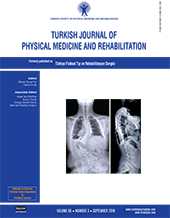Functional recovery and blood pressure on acute post-stroke setting
Patients and methods: A total of 116 ischemic stroke patients (60 males, 56 females; mean age 70.0±12.8 years; range, 37 to 93 years) who were admitted to the ARF between January 2012 and September 2012 were included. Daily BP measurements with mean systolic and diastolic BP values and Functional Independent Measure (FIM) scores at the time of admission and discharge were measured. The LOS and systolic and diastolic BP ranges were also recorded.
Results: There was no significant correlation between the BP and FIM scores. The mean diastolic BP was positively correlated with admission (rs=0.316, p=0.01) and discharge (rs=0.287, p=0.002), FIM scores, and FIM effectiveness (rs=0.185, p=0.047) and negatively correlated with age (r=-0.449, p<0.001) and LOS (rs=-0.189, p=0.042). The LOS in hospital was negatively correlated with FIM scores at admission (rs=-0.585, p<0.001) and discharge (rs=-0.352, p<0.001) and positively correlated with FIM score changes (rs=0.414, p<0.001).
Conclusion: Our study results show that diastolic BP in the subacute phase of stroke does not have a major impact on the functional recovery and LOS in post-stroke patients. However, there is a significant correlation between diastolic BP values and FIM efficiency.
Keywords : Acute rehabilitation unit, blood pressure, functional recovery, motor recovery, stroke
















